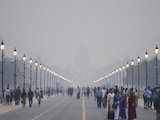US President Donald Trump has labelled India as the "Tariff King" and an "abuser" of trade duties, suggesting the country unfairly protects its markets through high customs duties. But a closer look at the facts reveals the claim doesn't hold up against actual trade data and global comparisons.
While India's simple average tariff is approximately 15.98%, the trade-weighted average, which better reflects the duties actually applied on traded goods, is only 4.6%, as per World Bank data, much lower than what is commonly believed.
Simple vs Weighted Average Tariffs
Simple Average Tariffs give equal weight to every product, even those hardly traded. Trade-Weighted Average Tariffs measure the actual duties paid based on trade volume.
In India's case:
Simple Average Tariff: 15.98%
Trade-Weighted Average Tariff: 4.6%
This means that most of India's high tariffs apply to sectors with low import volumes, such as agriculture or automobiles. In contrast, the bulk of US exports to India - pharmaceuticals, energy products, machinery, and chemicals - face much lower duties, typically 5-8%, as per official data.
A significant portion of India's imports enter duty-free, thanks to various schemes like:
- Special Economic Zones (SEZs)
- Export-Oriented Units (EOUs)
- Free Trade Agreements (FTAs)
India's Actual Tariffs On US Goods
In FY 2023-24, India imported over $42.2 billion worth of goods from the United States. Nearly 75% of this trade came from only 100 key product categories, and most of these faced low or minimal tariffs.
Examples -
- Crude Oil and LNG: Import duty of Rs. 1.1/tonne and 2.75%, accounting for 18.25% of US imports to India.
- Industrial Machinery: Tariff of 7.5%, making up 9.75% of imports.
- Coal: 5% duty, contributing to 8.8% of imports.
- Medical Equipment: Duties between 5% and 7.5%, with a 4.6% import share.
- Aircraft and Parts: Low tariff of 2.5%, with 3% of total imports.
- Fertilisers: Tariff ranging from 7.5% to 10%, making up 1% of imports.
Compared To Other Countries
When stacked against other countries, both developed and developing, India's tariffs are far from extreme, sources say.
As per data from the World Trade Organisation:
Electronics And Technology
India: 0% on most semiconductors, IT hardware, and computers
Vietnam: Up to 50%
China: Up to 25%
Indonesia: Up to 30%
Agricultural Products
- India: Average 33%, max up to 110-150%
- European Union: Up to 261%
- Japan: Up to 298%
- South Korea: Over 800% on some items
While India's simple average tariff stands at 15.98%, as per the WTO, this figure is well within the range of tariffs maintained by other developing nations. For instance:
- Bangladesh: 14.1%
- Turkiye: 16.2%
- Argentina: 13.4%
By this measure, India's weighted average is just 4.6%, which is:
- Lower than Vietnam (5.1%) and Indonesia (5.7%)
- Nearly equal to the European Union (5%)
India Has Been Reducing Tariffs For Decades
- In 1990, India's average tariff was as high as 80.9%.
- Following economic reforms in the early 1990s, tariffs were gradually reduced, falling to 33% by 1999.
- By 2023, India's simple average tariff dropped further to 15.98%, while the trade-weighted average stood at 4.6%.
In January, India implemented extra tariff cuts on key US products:
- Motorcycles above 1600cc: reduced from 50% to 30%
- Motorcycles up to 1600cc: cut from 50% to 40%
- Bourbon whiskey: slashed from 150% to 100%
- Carrier-grade Ethernet switches: halved from 20% to 10%
- Synthetic flavouring essences and mixtures: steeply reduced from 100% to 20%
- Fish hydrolysate: lowered from 15% to 5%
- Equalisation Levy on online services: 6% levy abolished after last year's removal of an additional 2% - significant for the US tech firms
In 2023, India removed retaliatory tariffs on major US agricultural exports like apples, almonds, and walnuts after resolving trade disputes.
High-tech goods and solar equipment have seen reduced or zero duties in line with India's strategic green energy and digital transition goals. Crucially, major US exports like aircraft and LNG continue to enjoy a low duty regime, facilitating over $5 billion in annual trade.
These reductions reflect not only India's broader trade liberalisation over the decades, but also a calibrated effort to strengthen economic ties with the United States through deliberate tariff concessions.
India's Non-Tariff Barriers
India's regulatory and safety standards are generally less restrictive than those of countries like the EU, Japan, or China.
- India's Maximum Residue Limits (MRLs) for food products are either matching or less stringent than international Codex standards in 24 out of 32 cases, compared to only 15 out of 52 MRLs in Japan and 6 out of 58 in the EU, as per sources.
- India's rules on biotech products and veterinary health certification are designed to be transparent, science-based, and consistent with global norms.
In contrast, China has over 2,600 non-tariff measures (NTMs), many of which are complex, unpredictable, and create difficulties for foreign exporters, sources said.
US Tariffs
The United States itself imposes very high duties on several important products. These tariffs, many exceeding 100% are applied across a range of products, including dairy, agriculture, textiles, and autos, reflecting deep-rooted domestic concerns similar to those seen in countries like India.
- Sour Cream: Average tariff of 197.04%, with rates going up to 297.79%
- Tobacco: Average 183.87%, maximum 350%
- Peanuts: Average 114.80%, up to 163.8%
- Cheese: Average 23.98%
- Automobiles: Average 19.28%
Developed countries like Switzerland (28.5%), Norway (31.1%), and South Korea (57%) also maintain very high agricultural tariffs, often exceeding India's levels, underscoring that protecting agriculture is a global norm.
India's tariff policy, especially in agriculture, is thus in line with international norms aimed at safeguarding domestic farmers and ensuring food security, sources said.















